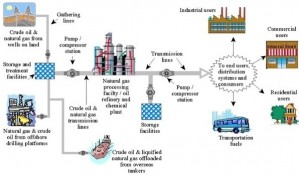Natural Gas Pipelines Overview
Natural gas pipelines enter the story of natural gas energy production after the hydraulic fracturing process is complete. The raw natural gas is pumped out of the wellhead and into the gathering pipeline system, which is composed of low pressure, small diameter pipes used to transport the gas to the processing plant. After the natural gas is processed it is transported to a distribution center through the transmission pipeline system at pressures ranging from 200 to 1,500 psi. Transmission pipes can measure between 6 and 48 inches but most are between 24 and 36 inches. Lateral pipes, used to deliver natural gas to or from the mainline, tend to measure between 6 and 16 inches in diameter (The transportation of natural gas, 2013). Gathering, transmission, and lateral pipelines are all made of an engineered carbon steel alloy. Along the transmission pipeline system, there must be at least one compressor station to pressurize the gas. From the distribution center, the natural gas is pumped directly to customer through the distribution pipeline system that consists of small pipes that may even be made of highly advanced plastic materials.
Phases of a Natural Gas Pipeline
